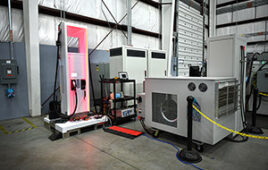New Tools for New Light Source at Brookhaven Lab
“Most of today’s technologies are built using bulk materials whose properties are not sufficient to enable next generation technologies,” added Dierker. “Although we understand quite a lot about the properties of bulk materials, we have not yet succeeded at improving their properties by the amount needed for the new applications. The challenge is to work dramatically below the bulk state, in the range of single atoms to tens of atoms. The NEXT project can give NSLS-II the advanced tools to do that.”
As the world’s most brilliant light source, NSLS-II will foster groundbreaking scientific advances. Brookhaven’s currently operating light source, NSLS, draws each year about 2,200 researchers from 400 universities, government labs, and companies to study a wide range of materials, from catalysts, to computer chips, to biological molecules.
To take their research to the next level — to probe even smaller, subtler details of their samples — scientists need more intense, better-focused light. NSLS-II will deliver world-leading intensity and brightness, producing x-rays 10,000 times brighter than the current NSLS. In fact, its x-ray brightness and resolution will exceed all other light sources, existing and under construction. This will enable the nanoscience revolution, giving scientists the ability to image materials down to a nanometer, one billionth of a meter — a capability not available at any other light source in the world.
The unique characteristics of NSLS-II will help scientists explore the grand challenges they face in developing new materials with advanced properties. It will pave the way to discoveries in physics, chemistry, and biology — advances that will ultimately enhance national security and help drive the development of abundant, safe, and clean energy technologies.
NSLS-II construction began in 2009, creating jobs and stimulating the economy. The facility is expected to start operating in 2015.
NSLS-II is funded by the Department of Energy Office of Science, which is also supporting the NEXT project. Visit the website for more info about the NSLS-II project.




